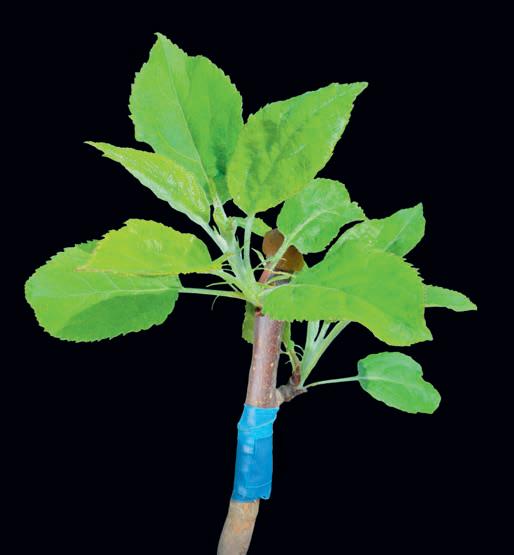Poging GOUD - Vrij
All About Grafting - an historic form of propagation
The Country Smallholder
|Spring 2025
Lee Senior explains the top technique for gaining increased vigour, disease resistance, yield and speed
-

Several decades ago, I remember as a horticultural student being shown grafted plants for the first time in a nursery field. At that time grafted plants were quite unlike anything I’d seen before with two plants basically joined together! How could this be?
We were shown and subsequently had a go at something that to this day remains one of the more intriguing horticultural techniques.
Inevitably over time, the use of broader grafting techniques has increased to the point where in many cases it is now the expected normal with a lot of plant nursery stock. These days it is quite unusual to buy a fruit tree that hasn’t been grafted by the nursery.
Grafting in its simplest form is a historic, time-served and rather skilful form of propagation- and there are many forms of it. There is no doubt it is a satisfying but challenging way to increase stock where other methods are not effective.
Grafting manipulates nature in a positive, well-intentioned way. It is a technique used to create new 'super' plants that will (it is hoped) outperform other non-grafted plants. There are plenty of things that can and do go wrong but commercially success rates are very good these days.
Meanwhile, whip and tongue grafting (a technique often used for fruit trees) is probably the one many of us are most familiar with.
In both cases the top half of the graft is the plant that grows in a normal way and is called a scion.
During splice grafting the scion is typically around 1-2 years old, pencil thick and should be cut to a length of 8-10 inches. The scion is then inserted into a cut made into the rootstock to match.
For the graft to be successful the scion needs to knit or 'fuse' with a different rootstock which has to be compatible with. The scion and rootstock need to be in tight contact with each other until they fuse or marry together. To achieve this a number of aides can be used such as tapes, bands, clips, seals and even wax!
Dit verhaal komt uit de Spring 2025-editie van The Country Smallholder.
Abonneer u op Magzter GOLD voor toegang tot duizenden zorgvuldig samengestelde premiumverhalen en meer dan 9000 tijdschriften en kranten.
Bent u al abonnee? Aanmelden
MEER VERHALEN VAN The Country Smallholder

The Country Smallholder
Preventing and Controlling Predators
Poultry are prey animals and, in the UK, there are a wide array of predators that can hunt them. Hugh and Fiona Osborne look at the predators to be aware of and how to guard against them.
7 mins
December 2025

The Country Smallholder
Showing our Turtle Doves some love this Christmas
Helen Moffatt says you can be part of Operation Turtle Dove on your smallholding
3 mins
December 2025

The Country Smallholder
On the third day of Christmas
The famous Christmas carol celebrates \"three French hens\", but what if we gave the verse a smallholder's twist? Cara Wheeldon introduces three festive bantam breeds that bring sparkle, charm, and cheer to coops across Britain this winter.
5 mins
December 2025

The Country Smallholder
Five ideas for inside food growing over winter
Editor and eco-expert Kim Stoddart outlines some more creative ways to bring the outdoors in this winter
3 mins
December 2025

The Country Smallholder
How to enjoy winter pig keeping
Linda Aldous says success is all in the preparation and in your clothing!
5 mins
December 2025

The Country Smallholder
Where next for Britain's smallholding and farming communities as we look to 2026 and beyond
Agricultural journalist, smallholder and editor of Ford & Fordson Tractors Magazine Jane Brooks, joins us for her regular look at the world.
4 mins
December 2025

The Country Smallholder
All dressed up with nowhere to show?
Grant Brereton says there's still cause for optimism with pure breeds
6 mins
December 2025

The Country Smallholder
When small businesses collaborate, things happen!
Angela Williams shows how by working with like minded people, you can create things you thought you could only dream
5 mins
December 2025

The Country Smallholder
Cluckin' around the Christmas tree
'Tis season of peace and goodwill to all hens
5 mins
December 2025

The Country Smallholder
The gentle giant Brahma - big and beautiful
Victoria Roberts BVSC MRCVS looks at a stately, docile chicken with an impressive history
2 mins
December 2025
Listen
Translate
Change font size

